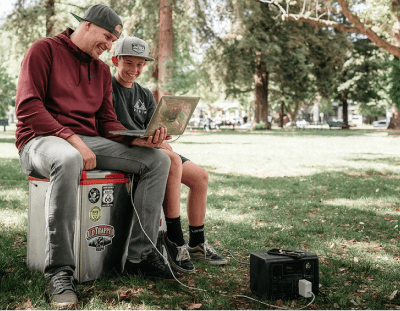The lithium ion solar battery is perfect for use in many places where you may not have access to a reliable power source. They can be used when camping or on a remote job site or in the back or a 4WD. These can last a good amount of time and can be set up in a series to give you the exact amount of power you require. These are easily recharged using solar panels, such as fixed solar panels or portable solar panels (e.g. foldable solar panels or a solar blanket).
At Outbax, we have many different lithium ion solar batteries and all of these can be ordered from our online store. We can ship them to you all over Australia and they'll be on your doorstep in less than 7 days. If you need assistance in choosing the right lithium battery for your needs, you can contact our team by phone (Monday - Friday, 9am-5pm) or by email.
How does a lithium ion solar battery work?
A lithium ion solar battery works in much the same way a standard battery works, except that it does not rely on a chemical process. Inside the battery, you 'll find a series of cells. Often, you 'll find four cells as each of these will produce a little over 3V, and with the four of them working together you get a 12V system. The cells are made of three main components; these are a positive electrode, a negative electrode, and a chemical separating them (this is known as the electrolyte). In most newer batteries, the positive electrode is made of lithium ion phosphate (commonly referred to as LiFePO4). The negative electrode is usually made from carbon, with the electrolyte being made of various chemicals (this is different for each manufacturer and largely unimportant to the function of the battery).
The way that the lithium ion solar battery works is that when it is charging, the LiFePO4 positive electrode will release some of its lithium ions, and these will travel through the electrolyte to the negative electrode and stay there. This is when the battery takes in charge and holds it there, ready for use. When the battery is discharging the lithium, ions move back and this provides the energy for the battery. The electrons inside the battery flow in the opposite direction to the lithium ions around the outer circuit, and not through the electrolyte. The movement of these two elements inside the battery are reliant on each other, if one stops so does the other. This means, if you turn off the circuit load, the battery no longer discharges at a fast rate. However, it will keep discharging, just at a very slow rate (which is why if you have a full battery on a laptop, it will lose charge over several days even if not used).
How long does a lithium ion solar battery last?
A lithium ion solar battery is rated based on how many cycles it can provide. This number may vary between different models. At Outbax, we are upfront about the exact nature of our batteries. In general, you can expect a quality battery to last over 2000 cycles, and they do not degrade over time (unlike standard AGM or lead-acid batteries).
Using 2000 cycles as a guide, this means that if the battery were to go through one full discharge each day, you can expect to get about five and a half years out of it before you see any drop in available power. But as you'll generally only use a portion of the battery, you may see this number increase dramatically. In most cases, people will use about 25% of the battery before charging it, so you'll get four days out of a single charge, even then you may not be using the battery each and every day. The main advantages of a lithium ion solar battery over AGM and lead-acid battery types is that when they're not being used, they are not wearing out. With lead-acid batteries, you'll only expect to get about 3-4 years out of them before they need replacing, and this is regardless of whether they get used or not.
To figure out which lithium battery is best for you, you'll need to add up the amount of power you'll be using in a day. All electrical equipment should have power usage marked on it, this may be in either amp hours (Ah) or watts. This number is related to how much power it will use in an hour. Have a look at all your equipment and decide how often you feel you'll be running it, and then tally that up. This will give you an estimate of how much power you'll be using in a 24 hours period. For the best results we'd recommend adding in around 25% higher than your calculation just as a precaution. Lithium batteries come in many different ratings, and at Outbax we have the 100Ah and 200Ah as our most popular batteries. They also come in a variety of styles and shapes, such as the slimline lithium battery for use in places where space is at a premium.
The batteries that we sell in the Outbax online store come with a four-year warranty as standard (unless otherwise stated), with some models having a five-year warranty. This protects you against any workmanship defects. All our items come with a 60-day returns policy, so if it is not exactly what you're after, you can contact our team and send it back to us. All our products have been tested by staff for their suitability in the Australian environment, and are considered highly durable. With zero maintenance required for the lithium ion solar battery, you're sure to have many years of reliable power.









